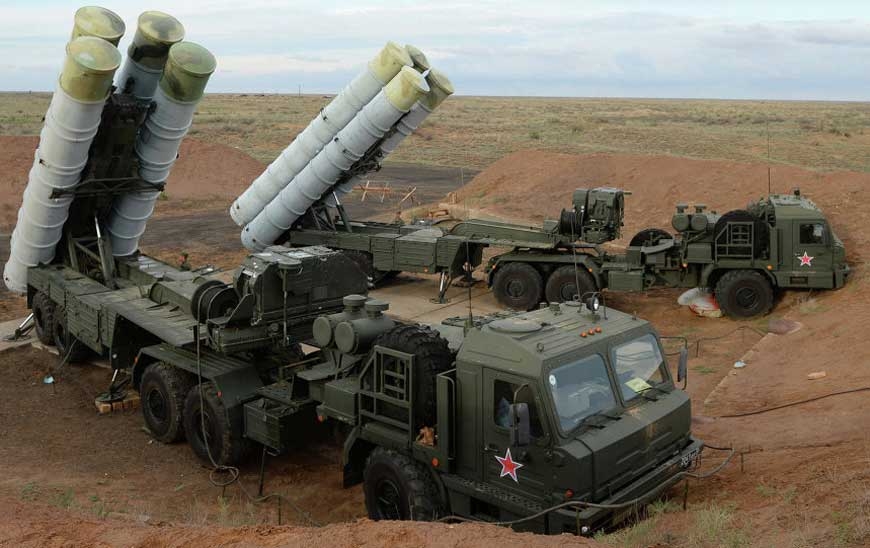[yt_dropcap type=”square” font=”” size=”14″ color=”#000″ background=”#fff” ] D [/yt_dropcap]uring the Indian Premier Narendra Modi’s last trip to Moscow, there was no progress made on the sale of missile defense system S-400 and Akula class nuclear submarines. Although two leaders were agreed on jointly producing Kamov-226 military helicopters and building nuclear power plants.
Indian defence ministry on the behalf of Indian Air Force showed interest in Russian S-400 Triumf air defense system. However the Moscow clarified it will never reciprocate to such request until India negotiates the joint Fifth Generation Fighter Aircraft (FGFA) development program. So it was explicable when there was no follow-up negotiated on S-400 sale during Modi’s visit. But at the sidelines of the eight BRICS summit, India and Russia agreed to sign an inter-governmental agreement for the procurement of four regiments of Russian-made S-400 Triumf.
The S-400 Triumf (NATO designation: SA-21 Growler) is a new-generation medium and long-range anti-aircraft missile system. This missile system was manufactured by the Almaz-Antey Corporation and contains multiple missile variants to counter stealth aircraft, UAVs, cruise missiles and sub-strategic ballistic missiles. It can strike planes and tactical ballistic targets at a distance of 250 miles (400 km). The Indian Air Force desires the S-400 to enhance its air defense systems. Meanwhile, the purchase of S-400 is a sign that India is far away in creating an indigenous operative anti-missile missile system.
Recently, Vladimir Drozhzhov, deputy head of Russia’s Federal Service for Military-Technical Cooperation (FSMTC) claimed that, “The Russian Federal Service has prepared a draft intergovernmental agreement on the supply of the S-400 systems to India and passed it on to our partners, so we are awaiting a response.” Whereas, Aide to the President of Russia and head of the Control Directorate of the Presidential Administration of Russia, Vladimir Kozhin said that “There are many of those who want it (the S-400 system) but the case is that we are not able to supply everyone with it and therefore we will not deliver it to everyone because the priority is the Russian army, however, the negotiations with China and India are underway,”
Russia has been using the S-400 Triumf system for countering strategic threats with respect to its requirements obligatory in context of Europe against the United States. Now in future, the probable existence of these missiles in the South Asia, especially under Indian command is certainly going to contribute as another problem for Pakistani military. The future proliferation of S-400 to India is a grave challenge for Pakistan and it rings alarm bells also for China. The Triumf air defense system is easy to transport, well networked and has a range to defend huge areas. The traditional non-stealth fighter jets are specific target for the system and completely useless in the region where this system is being installed.
Some analysts contemplated that the best counter to the Triumf system is a long-range Surface to Air missile (SAM), for instance the Chinese HQ-9. Whereas, the genuine measure against Triumf system is to obtain a comprehensive ability which would preferably destroy India’s air defence capabilities. There are numerous methods available to counter an air defence system i.e. Suppression of Enemy Air Defenses (SEAD), Directed Energy Air Defense (DEAD), radar decoys, stealth air strike, drone air strike, cruise missile and ground invasion. Theoretically the conventional answer for Pakistan Airforce is to attain stealth aircraft along with anti-radiation air-to-surface missiles and sub-munition capable air launched cruise missiles (ALCM). Whereas Pakistan Army should invest in multiple independently-guided re-entry vehicle (MIRV) equipped ballistic missiles to counter any future acquisition of S-400 by India.
Sputnik reported last year that Beijing had already concluded $3-billion worth deal to purchase the S-400 Triumf from Moscow and it will receive the first batch as early as 2016. Therefore it is quite possible that China will be first beneficiary of S-400. In such scenario China will definitely not on the same page with Russia to supply such important strategic weapons to India. Whereas Russia can no longer ignore China’s likes and dislikes in contemporary picture. The reason for such closeness between Moscow and Beijing is pragmatic sanctions on Russia by the West and China’s unconditional support to Russia in this critical passage of time.
Meanwhile, the U.S. is quite concerned with Russian S-400 air defense systems going global. The U.S. is sensitive on the issue of deploying this system in any region especially in South Asia because this will put restrictions on the U.S. manoeuvrability in the region, as one senior U.S. Marine Corps said that, “(S-400) a complete game changer for all fourth-gen aircraft (like the F-15, F-16 and F/A-18). That thing is a beast and you don’t want to get near it.”
On the other hand the U.S. is building case to mainstreaming India into the Missile Technology Control Regime (MTCR). Therefore, India has to align itself according to MTCR guidelines but by the purchase of S-400 system it is violating the MTCR Guidelines and risking the proliferation of weapons of mass destruction.
The S-400 Triumf system under India’s command will contest Pakistan’s capability to conduct Air defense or Air offense operations in its airspace. It will also augment India’s ability to counter Pakistan’s aerial preeminence. Pakistan will be forced to invest in technologies to counter or develop comparable systems to highlight weaknesses in India’s air defenses to uphold regional balance.


